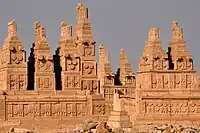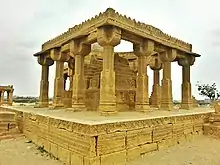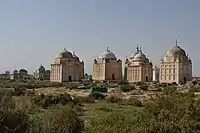Principality of Kalmat
After the fall of the Makran Sultanate (mid 12 - early 14 century AD) the subsequent Baloch state of Kalmat (14 - mid 17 century) flourished in the coastal region stretching from Pasni to the south in the Hub River. They actively participated in maritime trade, and Kalmat became a prosperous state and served as a stronghold for the further advance of the Kalmati tribe into the Habb and Indus valleys.[2] The kingdom was ruled by Baloch chiefs with the title Malik from Khub Malir.
Kech - Makran Kingdom Wilāyat - i Xôd | |||||||||||||
|---|---|---|---|---|---|---|---|---|---|---|---|---|---|
| 14th–17th | |||||||||||||
 Territory of independent Balochi chieftains between the 14th and 16th centuries, and 17th Mughal vassals | |||||||||||||
| Capital | Kalmat, Pasni | ||||||||||||
| Government | Hereditary monarchy | ||||||||||||
| Malik [1] | |||||||||||||
| History | |||||||||||||
• Established | 14th | ||||||||||||
• Disestablished | 17th | ||||||||||||
| |||||||||||||
| Today part of | Pakistan
Iran | ||||||||||||
aThe Baloch Confederation of Hott (or Hooth of Kalmat) became powerful. As a coastal state, it expanded its maritime trade and also influenced the entire coast of Balochistan right down to the sea. From the 13th to the 16th century, there were no Mongol and Timurid invaders, the desert and severe heat saved the principality of Kalmat from the Asian invaders. Originally they are Hoat, but due to their independent principality at Kalmat, in Mekran, they are called "Kalmatis". | |||||||||||||
Pehlevi texts mention the form Makuran, corresponding to the form used in the Baluchi language. The orthographical writing Makran is found for the first time in early Islamic texts. The toponym Meluhha being mentioned in Sumerian and Old Akkadian texts, is generally presupposed to have been located east of Magan, because in most texts, where these toponyms occur one after the other, Magan is mentioned first. She has provisionally concluded that Magan appears to have covered the Oman, south - east Iran and Makran regions. Attention is also drawn to the etymological connexion between Magan, Old Persian Maka and Makran. Meluhha is said to be connected with Assyrian 'Baluhha' which was later Islamised as 'Baluch'. Baloch are the later descendants of the ancient Meluhha, these last in turn to be identified also with the Mleccha, mentioned in Sanskrit texts from ca. 600 B.C. onwards as a barbarian people living beyond the Indus.
_of_Shah_Tahmasp_MET_DP107164.jpg.webp)
The Malik Dynasty
After the death of Mir Jalal Khan, his youngest son, Mir Hoat, occupied the country which lasted until the middle of the 16th century. Then the country came under the rule of the Malik dynasty. Nothing is known about the racial identity of the Malik dynasty. Marco Polo mentioned an independent Malik dynasty in Makran in these words, "Kesmacoran ( Kech - Makran ) is a kingdom having a king of its own with a peculiar language". It seems that with the rise of the First Baluch Confederacy, Maliks accepted the Baluch supremacy which continued into the middle of the 16th century. The most distinguished and famous Malik rulers of Makran were Malik Saeed, Malik Tajuddin, Malik Badr, Malik Zahid, Malik Dinar, Malik Jalaluddin, Malik Muzafar, and Malik Kuchku. During the rule of the Malik, the borders of the state of Makran were extended to Malik Chedag near Minab in eastern Iran. Ross wrote that Makran attained its zenith under them, increasing its population. In the 17th century, the Malik dynasty was replaced by the Buledi Baluch.[3]
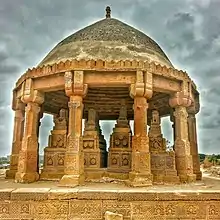
United tribes
History goes back to the period when Mekran, as a single independent country, was ruled by a ruling family known as Maliks. According to them, constitutionally it was a single state, but divided into several general governments or provinces, each of which belonged to Malik, who had absolute power in his province. They were again subdivided into districts and dependencies directly ruled by hereditary petty chiefs. These provinces made up the Baloch Federation, united under one supreme authority (always the Governor of Kej province), who received reverence and tribute from the rest, and to which all quarrels between the members of the Federation belonged, and under which they all united. their forces to repel attacks from outside or invasion of the territory of common enemies.[4]
History
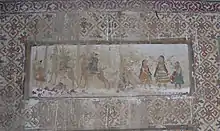
The principality of Kalmat is fragmentarily distributed in various medieval documents, mainly the history is preserved in traditional Baloch legends, and also in the Chaukhandi tombs the texts of the names of the rulers, as well as Sindhi historians of the 17th century, give information about the principality of Kalmat, recalling the romantic history of Sassui Punnhun.[5] According to Tarikh-i-Masumi, during the reign of Muhammad bin Tughluq in 1326–1327. The Balochs were engaged in a battle with the Soomra ruler near Bhakhar. Soomro had to call in a large army to oppose the Balochs. The Balochs also came into conflict with the Tughlaq at the same time, but Mohammad Shah arrived from Daulatabad with a huge army, defeated the Balochs and ordered the shedding of a river of Multan blood, and then appoint his people in Sevistan-Bukkur and Multan. It is clear that by then the Baluchis had spread to Multan. Again during the reign of Feroz Tughlak, Jam Khair-ul-Din Soomra, ruler of the Tatha, marches against the Balochs of Sodha and Jaredj, but upon reaching their border, Ranmal Sodha and Mirhan Baloch made great offerings. Shortly thereafter, Mihran Baloch and Ram Rai Jareja sided with Doda II, the next ruler of Soomra, and suppressed a rebellion in the interior of the Baloch country, and killed Ranmal Sodhu in Tukhri. They are again shown fighting the next ruler of Sumera, Jam Tughlak, near Bukkur, who had to muster a large army to defeat them.[6]
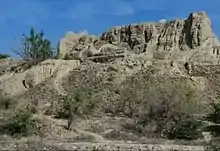
According to Ain-i-Akbari, the Lakhi ranges is inhabited by an important Baluch tribe is located therein, whom they style Kalmati, consisting of 20,000 families, among whom are 1,000 horsemen . An excellent breed of camels is produced here. Another branch ( of the mountains ) extends from Sihwan to Siwi and that is known as the Kahtar ( the modern Kirthar ) range, and is the dwelling place of the tribe of Nuhmardil Baluchis who muster 300 horsemen and 7,000 foot. Below this again is another tribe of Baluch, known as Zehri numbering 1,000 persons.[7] Also, the historian Farishta reports in 1475 about the Baloch Ismailis who had 40,000 armies, and were in conflict with the Samma dynasty. According to author Zafar-ul-Walih, the Baloch had a huge naval army that surrounded the weight of Sindh and occupied the rivers, they were skilled in archery, lived on the seashore, obeying no one. The Balochs dispersed and reclaimed legal territory. to the ruler of Sindh, having learned about the approach of Mahmud (Prince of Gujarat).[8]
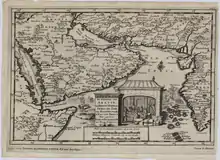
In the middle of the 16th century, the Portuguese historian and writer João de Barros calls Kalmat a principality, the country of Nautaques, because in the south of the country, on the banks of the Makran, the Nouthani territory was established by a tribe, João de Barros reports that there are no large cities in the state of these Balochs. They have villages in the mountain ranges, and this river makes them very powerful because it irrigates the entire plain. The land itself produces a lot of food: wheat, barley and fruits. Most of them are pirates and use light boats. They are archers, and when they have the opportunity, as many as two hundred confuse the sea with plunder, and sometimes they reach Hormuz, Iran and enter the courtyard. Sometimes Balochs hijack any ship that crosses the river into their territory. They are not afraid of any of the neighboring people. The Baloch tribes that sow and cultivate the land have many horses and many mares, which they ride like nomads. These people live in peace and friendship with the Rajputs and angry with the Persians. The Nodhakas are very close to the Rajputs, and although they have lived in the lands surrounded by the Moors for so long, they have never been conquered. They are a brave warrior. The Baloch country is larger and more populous than the Rajput land, but the Rajputs are the best people. But Joao de Barros did not know who the king of the Baloch was.[9]
Olfert Dapper (1636-1689) Dutch physician and writer. He wrote books on world history and geography, writes: “The leader of Guadelia (Gwadar) has his own supreme leader, who is called “Xeque”(Hott) Ruler of Makran.[10]
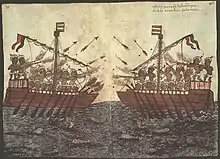
The Balochi country in the 16th century was also visited by the Ottoman Admiral Seydi Ali Reis in the 1550s and is mentioned in his book Mirat ul Memalik (Mirror of the Countries), 1557. According to Seydi Ali Reis, the inhabitants of Gwadar were Baloch, and their head was Malik Jelaleddin, the son of Malik Dinar.[11]
This is a long coast, but we could find no harbor, and we roamed about for two days before we came to Kichi Mekran. As the evening was far advanced we could not land immediately, but had to spend another night at sea. In the morning a dry wind carried off many of the crew, and at last, after unheard-of troubles and difficulties, we approached the harbor of Sheba.
Here we came upon a Notak, i.e,., a brigantine, laden with spoils, and when the watchman sighted us they hailed us. We told them that we were Muslims, whereupon their captain came on board our vessel; he kindly supplied us with water, for we had not a drop left, and thus our exhausted soldiers were invigorated. This was on Bairam day, and for us, as we had now got water, a double feast-day.
Escorted by the said captain we entered the harbor of Guador. The people there were Beluchistanis and their chief was Malik Djelaleddin, the son of Malik Dinar. The Governor of Guador came on board our ship and assured us of his unalterable devotion to our glorious Padishah. He promised that henceforth, if at any time our fleet should come to Ormuz, he would undertake to send 50 or 60 boats to supply us with provisions, and in every possible way to be of service to us. We wrote a letter to the native Prince Djelaleddin to ask for a pilot, upon which a first-class pilot was sent us, with the assurance that he was thoroughly trustworthy and entirely devoted to the interests of our Padishah.[12]
The Baloch state recognized the supremacy of the Ottoman Caliph and promised further cooperation. The Portuguese under the command of D. Luis de Almeida failed in the pursuit of the Ottomans, the Balochs after becoming allies of the Ottomans, they strongly defended the Turks. Louis destroyed several cities and burned many terraces in Baloch. But the Baloch never received news or support from the Ottoman Caliph.[13]
XXIII - by the same ship a jew came from Sindi who had lately dwelt in Ormiiz, and came to Sindi by sea from Guadèl, which is a Port of the Kingdom of Kics and Macran, t and was come to Guadel by land from Sphahán . He was a sagacious person, and affirmed to me for certain that the Prince of Kic and Macran was a friend of, and obedient to the Persians, and that there passed through his Country infinite Cafilas) of Merchandise which came from India upon Camels; and that this way was not onely frequented since the taking of Ormuz, which was declined through the War, but was also very secure, and afforded much profit to the said Prince of Macran, because at Guadel he received divers Customs of the abovesaid Merchandise; and before this pass was open he had no profit at all. Yet this Jew could not tell me whether this friendship and obedience of the Macranite to the Persian was because the Prince, who reigned there, was dead, and was succeeded by his younger Brother, who many years ago had fled into Persia to the Sciàh, as I have elsewhere mentioned in this Diary,” or else because the two Brothers never agreed together, and that he who reign'd still, either for his own interest on account of the said passage of the Cafilas, or through fear since the taking of Ormız, or perhaps forced by War, or other like Accidents, had dispos'd himself to be friendly and obedient to the Persians.[14]
Battle with Tarkhans
During the Tarkhan dynasty rule, Mirza Muhammad Salih, who had taken over all powers from his father Mirza Isa and ruled recklessly from Thatta, led on attack against a Kalmati settlement resulting in the ruthless massacre of women and children. Murid Khan, Kalmati Chief, who was then in Gujrat and whose father and family and other men had been killed, vowed on return to avenge the loss by killing Mirza Saleh single-handedly in broad day light . He kept his words, snatched an opportunity and fell upon Mirza who was then riding his horse and injured him fatally. The Mirza died the same day soon there after on 23 Sha ' ban 970 A . H . ( 1563 ). Such was the impact of this daring deed that no ruler there after proceeded against the Kalmatis arbiterarily. This event has continued to echo through history and oral tradition . In historical works, the name of Kalmati leader has been mentioned as Murid Baluch . The Kalmati elders of Mirpur Sakro recite a contemporary Sindhi verse on the vow made by Murid Khan who they confirm belonged to the Baloch ' clan of the Kalmaties. This stopped the Tarkhans from invading the Kalmati territory. By the end of sixteenth century, the Kalmati Maliks of Malir had extended their power to the Sakra region, and would seem to have befriended Khan-i-Khanan when the latter visited the Lahiri Port in 1591 A . D .[15]
See also
References
- Taagepera 1997, p. 495.
- Dani, Ahmad Hasan; Masson, Vadim Mikhaĭlovich; Harmatta, János; Litvinsky, B. A.; Bosworth, Clifford Edmund (1992). History of Civilizations of Central Asia. Motilal Banarsidass Publ. ISBN 978-81-208-1595-7.
- Baloch, Inayatullah (1987). The Problem of "Greater Baluchistan": A Study of Baluch Nationalism. Steiner Verlag Wiesbaden. ISBN 978-3-515-04999-3.
- Society, Bombay Geographical (1868). Transactions of the Bombay Geographical Society. Bombay Geographical Society.
- Hasan, Masudul (1998). History of Islam: Classical period, 1206-1900 C.E. Adam Publishers & Distributers.
- Marri, Mir Khuda Bakhsh (1964). The Balochis Through Centuries: History Versus Legend.
- Baluch, Muhammad Sardar Khan (1977). History of Baluch Race and Baluchistan. Gosha-e-Adab : distributers Nisa Trader.
- The Samma Kingdom of Sindh: Historical Studies. Institute of Sindhology, University of Jamshoro. 2006. ISBN 978-969-405-078-2.
- Farinha, António Dias (1991). Os portugueses no Golfo Pérsico: (1507-1538) : contribuição documental e crítica para a sua história (in Portuguese). Comissão Nacional para as Comemorações dos Descobrimentos Portugueses.
- Dapper, Olfert (1672). Asia, of naukerige beschryving van Het Rijk des Grooten Mogols: En un groot gedulte van Indiën : Behelsende De Landschappen van Kandahar Kabul ... ; Verciert doorgaens met verscheide Afbeeldgen in Kooper gesneden (in Dutch). Meurs.
- Minṭaqagahī̊, Muåssasah-i Farhangī-i (1967). Journal of the Regional Cultural Institute. Regional Cultural Institute.
- "Internet History Sourcebooks Project". sourcebooks.fordham.edu. Retrieved 2021-05-10.
- Titus, Paul Brian (1996). Marginality and Modernity: Ethnicity and Change in Post-colonial Balochistan. Oxford University Press. ISBN 978-0-19-577633-1.
- Valle, Pietro Della (2010-06-24). Travels of Pietro Della Valle in India: From the Old English Translation of 1664. Cambridge University Press. ISBN 978-1-108-01354-3.
- Pakistan Archaeology. The Department. 1991.
